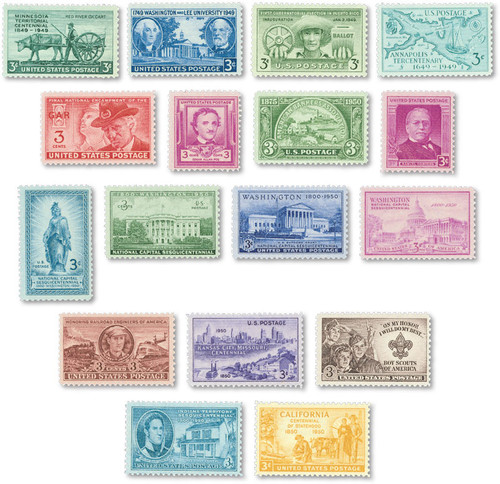
1949 3c Washington and Lee University
# 982 - 1949 3c Washington and Lee University
$0.35 - $18.50
U.S. #982
1949 3¢ Washington & Lee University
Issue Date: April 12, 1949
City: Lexington, Virginia
Quantity: 104,790,000
Printed By: Bureau of Engraving and Printing
Printing Method: Rotary Press
Perforations: 11 x 10 ½
Color: Ultramarine
In 1749, Scotch and Irish immigrants founded Augusta Academy, a small classical school deep in the Virginia valley. Inspired by patriotism, the academy trustees changed the name to Liberty Hall. The school relocated to nearby Lexington four years later and was empowered by the Virginia legislature to grant degrees.
In 1796, George Washington saved the struggling academy with an endowment of $20,000 worth of stock. In gratitude, the trustees changed the schools name to Washington Academy. The donation was one of the largest in its time and continues to offset the universitys operating budget today.
General Robert E. Lee served as the president of the university in 1865. Under Lee's direction, the university offered the first college courses in business and journalism in the United States. After Lee's death in 1870, trustees changed the name to Washington and Lee University.
U.S. #982
1949 3¢ Washington & Lee University
Issue Date: April 12, 1949
City: Lexington, Virginia
Quantity: 104,790,000
Printed By: Bureau of Engraving and Printing
Printing Method: Rotary Press
Perforations: 11 x 10 ½
Color: Ultramarine
In 1749, Scotch and Irish immigrants founded Augusta Academy, a small classical school deep in the Virginia valley. Inspired by patriotism, the academy trustees changed the name to Liberty Hall. The school relocated to nearby Lexington four years later and was empowered by the Virginia legislature to grant degrees.
In 1796, George Washington saved the struggling academy with an endowment of $20,000 worth of stock. In gratitude, the trustees changed the schools name to Washington Academy. The donation was one of the largest in its time and continues to offset the universitys operating budget today.
General Robert E. Lee served as the president of the university in 1865. Under Lee's direction, the university offered the first college courses in business and journalism in the United States. After Lee's death in 1870, trustees changed the name to Washington and Lee University.








